Built-in hood: advice on selection and installation

Built-in household appliances can significantly save space and make the interior much more concise. The kitchen is no exception. Kitchen hoods have recently become very popular, because this device purifies the air, eliminates odors that arise during the cooking process. Such a hood can be built-in, which will allow not to spoil the interior of the kitchen with a bulky, visually prominent structure.

Characteristic
Undoubtedly, the smell of delicious homemade dishes brings coziness to the atmosphere of a house or apartment. However, with constant and frequent cooking, this smell often fills almost all rooms. It literally impregnates pieces of furniture close to the stove, kitchen curtains, wallpaper. Soot from boiling foods and liquids, as well as small particles of fat, eventually cover the stove itself, adjacent tables and walls. Greasy stains are a good breeding ground for mold and bacteria growth.
It is not so easy to clean up such contamination. Housewives often have to do the cleaning. In this case, you need to use various cleaning agents and spend a lot of effort to clean kitchen surfaces. But the most unpleasant thing is that after a while, soot, fumes, grease and odors accumulate again on objects and furniture in the kitchen.
One of the sayings says: "Clean, not where they often clean, but where they don't litter." You can transfer the essence of this phrase to the above problem. Then it turns out that it would be necessary to somehow reduce or completely eliminate the formation and accumulation of dirt that occurs during cooking on the stove.


For many years, special hoods have been used to clean the air in the kitchen. Recently, they have gained particular popularity.
This ventilation device is installed above the cooker (gas or electric). Taking air into itself, the hood catches and draws in steam, soot, fat particles that are formed during the preparation of hot dishes. This prevents contamination and odors from spreading through the kitchen.



According to the principle of air ventilation, there are the following types of hoods:
- Flow-through exhaust structures. This is a simpler version of the ventilation device. The polluted air taken from the kitchen passes through filters and is removed from the room to the street. Such hoods are built into the ventilation system of an apartment building or have an exit directly to the street through the wall. The hood is equipped with built-in charcoal filters. They are designed to retain soot and grease. Such contaminants can accumulate in the exhaust pipe of the ventilation system and over time clog it or significantly reduce the air draft.



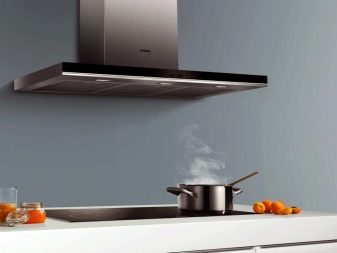
- Recirculation hoods. Such an air-cleaning system filters air masses, cleans them and returns them back to the room. Such a hood has a much larger number of filtration systems. In addition to retaining soot and vapors, the system cleans the air taken from the kitchen from odors. The filter elements in such a ventilation structure must be replaced periodically. Such hoods are much more convenient for use in the cold season, since air recirculation significantly reduces heat loss.




Also, the hood can be open or built-in.
The first type of air-cleaning structures is a unit located above the surface of the plate. It consists of a catching flat or domed element and a pipe for removing air masses. The exhaust pipe, in turn, is connected to the ventilation system. All structural elements are not covered by anything.



The built-in hood is partially or completely hidden from view and does not draw attention to itself. The catching recessed surface is fixed in the lower countertop of the wall cabinet above the stove. The main structural elements remain hidden behind the sashes. The air intake plate is only visible when you look directly under the wall cabinet. A small section of the exhaust pipe sometimes remains visible.
The fully recessed ventilation structure is also installed in the furniture. All parts of it are hidden from view.
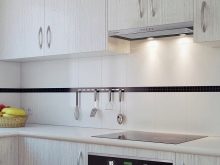
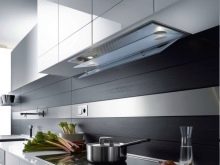

It is worth saying a few words about the filters used in modern kitchen hoods.
For the most part, they are divided into two types and have two main functions:
- Charcoal filter, which is available in all types of ventilation units. It works to eliminate odors and retains soot and greasy dirt. The filter element must be replaced during operation as contamination accumulates in it.

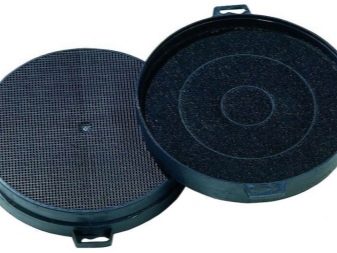
- Non-woven and synthetic winterizer filters they catch and retain combustion products, fumes from boiling liquids, soot, greasy and oily particles. Cassettes with these filter elements can be plastic or steel.


Plastic cassettes (they are most often produced by manufacturers recently) need to be replaced as contaminants accumulate in them. Filter cassettes made of steel or aluminum must be cleaned periodically.
The dimensions of the hood depend, first of all, on the dimensions of the working surface of the gas or electric stove. Also, the size of the entire filter unit is affected by its power, set of functions and the degree of purification of air masses.



Advantages and disadvantages
The popularity of cooker hoods in recent years has been observed for a reason. Often, buyers purchase even rather expensive, but multifunctional cleaning systems.
After all, the installation of built-in ventilation equipment in the kitchen has a lot of positive aspects:
- Aesthetic appearance, space saving. The entire design of purification and filtration is almost invisible in the interior of the room. The ventilation unit is simply integrated into furniture that matches the style of the kitchen.
- Eliminate cooking odors. The aroma of ready-made meals is often very pleasant, but it can literally eat into furniture over time. It's not very good when kitchen smells fill other rooms in the apartment and linger there for a long time. In addition, during the cooking process, rather unpleasant aromas are often formed (for example, in the first minutes of boiling fish or meat).
- Catching soot, vapors, grease particles from the air above the stove. This practically eliminates the sedimentation and accumulation of dirt on the stove itself and the surrounding objects or walls, which, in turn, improves the sanitary condition of the kitchen and eliminates the need for very frequent and time-consuming cleaning.
- Ensuring an intensive inflow of fresh (in the case of using flow-through ventilation) or purified (in the process of recirculation) air into the room.



The disadvantages of built-in hoods include the following points:
- The relative high cost of some multifunctional models. Hoods with a large number of filters and functions of particularly thorough air purification are especially hit in the pocket.
- Some difficulties can be caused by the selection of a ventilation structure for a slab of a non-standard size. If the dimensions do not match, you should choose a hood that will be wider, and not narrower than the dimensions of the slab surface.
- Units designed for large rooms are often quite noisy.This disadvantage becomes especially noticeable during intensive work in the maximum filtration mode.
- When the hood operates with a direct type of air exhaust (to the street) in the cold season, heat loss from the room may occur.
- Due to their relative compactness, built-in ventilation units are often inferior in power to standard open models.
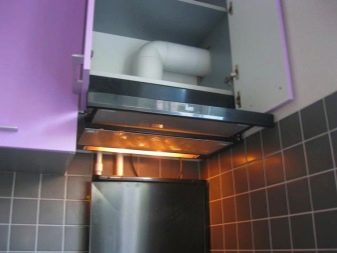

Functionality
Next, we will consider the functions and capabilities that are most often equipped with built-in hoods. Each specific model, of course, has a different set of functionality. It is worth familiarizing yourself with the main and most common ones. This will help you choose the hood that is suitable for you and not overpay for possibly unnecessary additional properties and capabilities of the unit.
The ability to adjust the power of the ventilation unit can be very useful. If food is cooked on several cooking zones, more intensive ventilation will be required. And if eggs are boiling on one of the burners over low heat, high filtration power is not required at all. This function will significantly save energy consumption, as well as reduce workloads on the hood itself.
The backlight function has recently been present in most models. It allows you to illuminate the work surface of the stove during cooking. The built-in backlight comes in different power and color spectrum. For the general interior of the kitchen, this is not such an insignificant parameter.
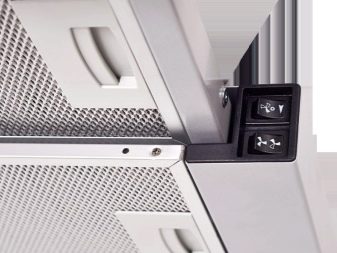
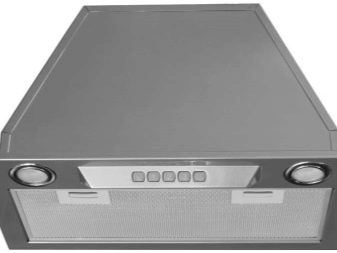


Quiet operation can be important in some cases. Usually, the noise level from the operation of the ventilation unit does not exceed 55-60 decibels. But for models with high power, the intensive ventilation mode can be quite noisy. The presence of a "quiet mode" allows you to reduce the sound load during the operation of the hood.
When buying, it is worth knowing that hoods with a recirculation type of ventilation are significantly more expensive, including in the process of operational maintenance. Units of this type return air back to the room, and this requires much more thorough cleaning. Therefore, several filters are installed in such hoods. During operation, most of them require periodic replacement.



The presence of a removable front allows you to replace it with a suitable color for your kitchen. If the store does not have a hood with a suitable front strip, you can subsequently purchase it separately and replace the previous one.
Most models of cooker hoods are equipped with filter clogging indicators. If it is triggered, it is necessary to clean or replace the filter element. However, there are still models where such an indicator is absent. In this case, one has to be guided by intuition regarding the degree of filter contamination. And this is not very convenient and often ineffective.
The presence of automatic functions for regulating the operation of the ventilation unit can also be very useful. True, so far, most of the very expensive models have a set of such functionality. The most common and useful ones are, for example, the function of automatic adjustment of the power of work, turning on the backlight when a person approaches the stove, automatically turning on ventilation when temperature sensors and air purity analyzers are triggered.


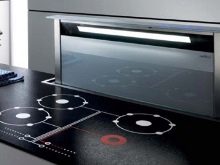
How to choose?
When buying, first of all, it should be borne in mind that each hood is designed for a certain area of the room. It will be ineffective if its capacity is insufficient. And an overly strong hood will mostly work idle in a small kitchen.
Therefore, immediately check the recommended room size for this model. Experts advise to choose a cooker hood with the declared area of the room 10-15% larger than the size of your kitchen. This will create a safety reserve and reduce the load on the unit.
Earlier in the article, such a parameter as the dimensions of the catch plate of the built-in hood was already mentioned. This size should be equal to or slightly larger than the dimensions of the surface of a gas or electric stove. Otherwise, the kitchen ventilation structure will not draw in all the vapors. So a certain amount of soot, fat will still settle on the hob, dishes and nearby objects. In addition, the hood, which is too small, will not be able to remove odors from the air well.
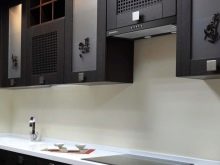

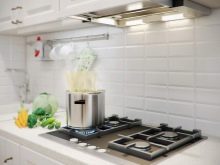
The most common models of a kitchen hood with a width of 60 cm. This is the standard size of the working surface of the stove.
The model you choose will depend on the type of ventilation you want. As already described above, it can be flowing or recirculating. Some installation features will also depend on the type chosen.
With flow ventilation, you will have to lay an air outlet pipe. And it is not always possible to hide or disguise it completely. The most aesthetically appropriate option is for a kitchen with tall hanging cabinets. In this case, the air exhaust pipes will be inaccessible to the eyes.



The second option is more expensive. But a significant plus is that the entire recirculation filtering structure can be closed with the doors of the same kitchen cabinet above the stove. Also, in this case, more frequent replacement or cleaning of the filter elements will be required.
Many modern models of hoods can work with any of the two types of filtration described above. The availability of such a possibility must be checked with the seller at the point of sale.
In each specific case, you will need to purchase the necessary set of components and carry out the installation in accordance with the recommendations and rules.




When choosing, you should familiarize yourself with the number of filters and their type. The more filter elements there are in the exhaust structure, the higher the cost will be. Also check with your consultant about the rules for caring for filters and their cost when replacing.
Decide in advance on the additional functions you need. Perhaps in expensive models there will be a lot of superfluous and unnecessary for you. At the same time, you should not skimp on a set of functionality that is really important and necessary for you.
Study the type of installation and installation features of the unit. Many models can be installed by hand. Non-standard dimensions of the device or design features may require mandatory installation by professionals.


How to install?
The installation of a kitchen ventilation unit can be carried out independently or with the assistance of professional craftsmen. In the second case, it remains to rely on their experience and skills. Therefore, further we will talk about how to install a built-in hood with your own hands.
Materials and tools required for installation:
- pencil or marker for marking surfaces;
- drill for wood 10 mm;
- electronic saw for wood;
- jigsaw;
- yardstick;
- drill;
- hammer;
- screwdriver and mounting screws;
- wooden linings;
- waterproof glue.


It should be remembered that the hob must be located strictly under the lower catching element of the hood. It should not be offset to the side relative to its working surface.
Next, a standard installation scheme for a built-in exhaust structure for a kitchen will be described:
- First you need to remove the cabinet doors and free its shelves.
- It is important to turn off the power supply in the apartment during the work.
- The hood should be hung no lower than 75 cm from the surface of the stove.
- Before starting to install the ventilation structure, it is necessary to mark the dimensions for the insert of the catching element on the bottom of the hanging cabinet. A hole for the hood is cut along the indicated contours. Also, in the lower part of the cabinet, recesses are drilled for self-tapping screws, on which the lower panel of the hood will be attached.For the convenience of carrying out these manipulations, it is better to remove the bottom shelf of the cabinet by removing the side fasteners.


- If there is one or more shelves in the cabinet, they should be removed. A more time-consuming option is to cut openings in the shelves for the air duct and other structural elements. All holes are made after preliminary measurements of elements and marking.
- For the air duct and the main part of the ventilation structure, fasteners are screwed on the rear wall of the cabinet and the wall behind it.
- If the duct pipe goes to the ceiling, a corresponding hole is made for it in the upper part of the cabinet.
- The lower catching element of the hood is fixed with self-tapping screws into a hole prepared for its dimensions in the bottom shelf of the cabinet. The whole structure is assembled and fixed.
- The air duct leads to the ventilation system. There it is fixed with glue, sealant and clamps. In private houses, you can use a puncher to punch a hole of the required size in a conveniently located outer wall and then vent the air from the room directly to the street.



If the ventilation unit operates as a recirculation, all its elements are mounted inside the cabinet above the stove. The final stage is the assembly of the cabinet and hanging its doors on the hinges.
Here are some useful tips for installing a built-in cooker hood yourself:
- Experts recommend avoiding unnecessary kinks in the duct. They significantly reduce the power of the ventilation system and make it more noisy.
- A quieter and more durable alternative to corrugated ducting is the round plastic pipe.
- If the hood works according to the flow-through principle, that is, it brings air masses into the ventilation system or outside, it is advisable to install check valves in the air duct. They will prevent air from being thrown into the room at a time when the ventilation unit is not working.
- It is recommended to stretch the corrugated duct well before installation. Its folds create additional noise when the air cleaning system operates.
- It so happens that the dimensions of the air intake element of the hood are wider than the size of the bottom of the cabinet. In this case, you will have to remove the lower shelf and use adjacent cabinets to fix the lower panel of the unit. The safest way is to entrust this work to professional craftsmen.



Popular models
Below is a rating of the most popular built-in hoods for the kitchen. It includes the best models with positive reviews from customers.
"Cata GT Plus 45 negra" - Spanish-made air cleaning system. This model is the best in its price range. With its compact dimensions, this hood has decent performance, beautiful design, excellent lighting system, and convenient operation. The filtration system allows you to clean the air in the room in the shortest possible time, even with an intensive cooking process and a large amount of vapors.


The Chinese system deservedly takes the second place in the ranking. Kamilla 1M 450 inox... The price of this hood is quite low, but this does not in any way affect the quality of its work. This model does not have a lot of power, but it is a good and laconic option for a small kitchen. The unit has a beautiful, discreet design. The air duct is equipped with an anti-return flap.
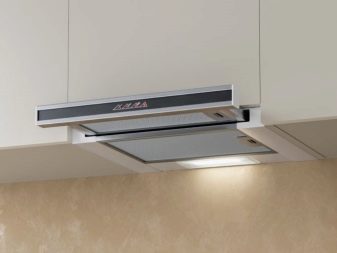

Another option with an affordable price tag is the model Elikor Integra 50... This is a domestic production unit. With a compact size, the hood has good power. The system is quiet enough even at maximum load. The appearance of the hood also does not cause complaints or comments from buyers.

German hood "Zigmund & Shtain K 005.41B", like the previous model, has a lot of positive reviews. This unit is very powerful and reliable. A big plus is its energy efficiency. Also, as an advantage, buyers note the low noise level during the operation of the air cleaning system.The hood has a retractable design and an eye-pleasing external design.

Virtually silent hood "Maunfeld Crosby Push 50" is ideal for studio apartments or large kitchen areas. At high power, this model is energy efficient. The unit has two built-in motors that allow you to clean the air in a very short time. Built-in lighting is provided by economical halogen lamps. As a plus, it is also worth mentioning the affordable cost of this model in comparison with similar ones.

Cooker hood from German manufacturers "Korting KHI 6673 GN" Is a great option for modern kitchens. Its main advantages are high power, 3-speed ventilation modes, very low noise level (51 dB), built-in timer, economical LED backlighting. The unit is equipped with an anti-return air valve.

Beautiful examples in the interior
A very interesting, stylish and fashionable option is the vertical hood. It is built into the worktop and is not located above the worktop of the stove, but on the side of it.


If the kitchen is decorated in a high-tech style, a panel with luminous touch buttons is a good option. The panel is designed in a metallic style.


A cooker hood with a white or beige panel is well suited for a classic design.

Soft spotlights in a warm color spectrum add a cozy ambience to your kitchen.

For information on how to install a built-in hood, see the next video.













The comment was sent successfully.